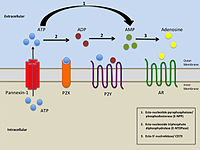
Photo from wikipedia
Disulfide-rich peptide toxins have long been studied for their ability to inhibit voltage-gated sodium channel subtype NaV1.7, a validated target for the treatment of pain. In this study, we sought… Click to show full abstract
Disulfide-rich peptide toxins have long been studied for their ability to inhibit voltage-gated sodium channel subtype NaV1.7, a validated target for the treatment of pain. In this study, we sought to combine the pore blocking activity of conotoxins with the gating modifier activity of spider toxins to design new bivalent inhibitors of NaV1.7 with improved potency and selectivity. To do this, we created an array of heterodimeric toxins designed to target human NaV1.7 by ligating a conotoxin to a spider toxin and assessed the potency and selectivity of the resulting bivalent toxins. A series of spider-derived gating modifier toxins (GpTx-1, ProTx-II, gHwTx-IV, JzTx-V, CcoTx-1, and Pn3a) and two pore-blocker μ-conotoxins, SxIIIC and KIIIA, were used for this study. We employed either enzymatic ligation with sortase A for C- to N-terminal ligation or click chemistry for N- to N-terminal ligation. The bivalent peptide resulting from ligation of ProTx-II and SxIIIC (Pro[LPATG6]Sx) was shown to be the best combination as native ProTx-II potency at hNaV1.7 was conserved following ligation. At hNaV1.4, a synergistic effect between the pore blocker and gating modifier toxin moieties was observed, resulting in altered sodium channel subtype selectivity compared to the parent peptides. Further studies including mutant bivalent peptides and mutant hNaV1.7 channels suggested that gating modifier toxins have a greater contribution to the potency of the bivalent peptides than pore blockers. This study delineated potential benefits and drawbacks of designing pharmacological hybrid peptides targeting hNaV1.7.
Journal Title: Bioconjugate chemistry
Year Published: 2023
Link to full text (if available)
Share on Social Media: Sign Up to like & get
recommendations!